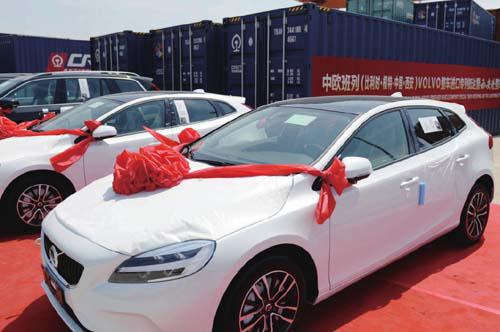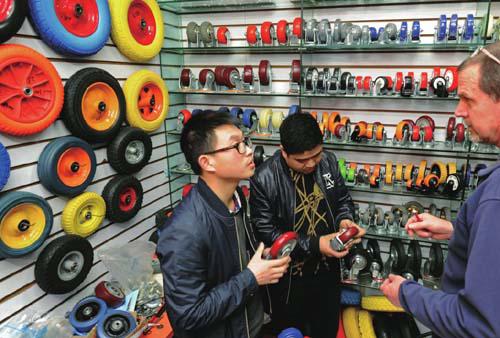A Moment Seized
2018-07-30ByMeiXinyu
By Mei Xinyu



China has comprehensively fulfilled its commitments to the World Trade Organization (WTO), substantially opened its market to the world, and delivered mutually beneficial and win-win outcomes on a wider scale, according to a white paper titled China and the World Trade Organization, released by the State Council Information Offi ce on June 28.
The Chinese Government published the white paper to give a full account of Chinas fulfi llment of its WTO membership commitments, explain Chinas principles, stances, policies and propositions regarding the multilateral trade system, and describe Chinas vision and actions in advancing higher-level reform and opening up, the document said.
China acceded to the WTO in 2001, a milestone in the countrys integration into economic globalization and the start of a new historic phase of market openness. Over the past 40 years, China has adhered to the fundamental national policy of reform and opening up and the pursuit of development with its door open to the world. Consequently, a model of comprehensive, multilevel and wide-ranging opening up has gradually taken shape.
In acceding to the WTO in 2001, China agreed to an annual review on the fulfillment of its accession commitments for the next eight years, with a fi nal review due in the 10th year. The review process, in which Western countries including the United States have the largest say, approved Chinas fulfi llment of its accession commitments for 10 years in a row. Nonetheless, some biased observers have made groundless accusations that China has not fulfi lled these commitments.
After accession to the WTO, Chinas share in the global import of goods expanded from just 3.8 percent in 2001 to 10.26 percent in 2017, according to data from the United Nations Conference on Trade and Development. With the rapid growth of imports, China evolved from an economic stabilizer in East Asia during the Asian fi nancial crisis of 1997-98 to become the ballast of the global economy after the global financial crisis of 2008. China, with robust import and investment demands, has lifted a number of countries and regions out of recession more quickly than they otherwise would have been.
The speed of Chinas own economic and trade growth is testament to the significance of its accession to the WTO. Developments in recent years also demonstrate that the most valuable aspect of Chinas WTO accession is that it coincided with a unique opportunity for growth. As the country sets out on the path toward further reform and opening up, the same resolve and courage should be retained.
Accession benefits
When China acceded to the WTO in 2001, some of its membership terms were controversial at home, such as allowing other WTO members not to recognize Chinas market economy status for 15 years and the imposition of transitional productspecific safeguard measures on Chinese products for 12 years, which were blamed for making Chinese businesses vulnerable in trade disputes. It thus required courage for China to accept these unfavorable terms in exchange for a window of opportunity for rapid economic and trade growth.
Chinas decision to join the WTO was vindicated by the drastic ascent of its global economic and trade ranking following its accession. Back in 2001, China accounted for 4.3 percent of the worlds total export of goods, ranking sixth globally following the United States, Germany, Japan, France and the UK. After its WTO accession, China gradually surpassed the worlds major economies in terms of exports.
By 2015, China accounted for 13.76 percent of global export of goods, a much larger share than the 9.1 percent of the second country on the list, the United States. Without WTO membership, China could never have realized such rapid growth. Despite its share in this category edging down slightly to 12.78 percent in 2017, China still leads the world by a wide margin and will remain the worlds largest exporter of goods for a long time to come.
With history in mind, Chinas achievements are all the more remarkable. The countrys share in the global goods export market is on par with that of the United States in the late 1950s and 1960s—the highest stake the United States was able to maintain even at the height of its peacetime power.
This was achieved largely due to the extent of the external market accessible following Chinas WTO accession, which prompted a surge in the size of the countrys manufacturing sector and economic aggregate. From 2001 to 2017, the business revenue of Chinas major industrial fi rms increased from 8.4 trillion yuan ($1.27 trillion) to 116.5 trillion yuan ($17.63 trillion), while the national GDP jumped from 11 trillion yuan ($1.66 trillion) to 82.7 trillion yuan ($12.52 trillion).
China has been able to accomplish such dramatic increases in its manufacturing sector, foreign trade and GDP in the past 17 years because the first decade of this century represented a window of opportunity to realize swift and sustained economic and trade growth, and China seized the moment by joining the WTO at the right time. As a latecomer, China was already equipped with the industrial foundation, human resources, infrastructure, economic structure and an administration system necessary to capitalize on these favorable conditions upon its admission to the WTO in 2001.
The fi rst decade of this century marked a high point in the boom-and-bust cycle. Throughout the noughties, technological innovation in areas such as information technology emerged and spread rapidly worldwide, the market economy system assimilated almost every economy in the world, and the multilateral trade system led by the WTO functioned stably.
In addition, following loose monetary policies, most central banks in the West, particularly the U.S. Federal Reserve, created suffi cient liquidity for other economies to support their own trade and economic growth. During this period, Western countries, the United States in particular, had a high level of market openness which created favorable conditions for this exportdriven group of economies.
Setting out again
Since 2015, however, these favorable conditions have begun to disappear or be reversed. The global economy has been in a bust period since the global financial crisis of 2008, and it could take a long time for the boom to return.
For now, there is no sign of any technological revolution powerful enough to galvanize worldwide growth as before. The stimulus effect brought about by the expansion of the market economy is disappearing and major central banks in the West, including the U.S. Federal Reserve are tightening their monetary policies which, once started, could remain in place for a long time to come.
Trade protectionism and anti-globalization are also on the rise. Since U.S. President Donald Trump took office, the global trade system has hit a patch of turbulence. Under Trumps leadership, U.S. economic policy has become increasingly domestic in focus.
The WTO is in its darkest hour. The Doha round of trade negotiations, which were supposed to conclude before January 1, 2005, made the first breakthrough in 2013 and later came to a halt. Various regional trade agreements are replacing the WTO as the major instruments of economic integration. The WTO has been plagued by these problems for over a decade, and since Trump assumed power, the United States, which has the largest impact on the organizations development, is dealing with its trading partners by bypassing the institution it created.
With its domestic industries maturing, China has overcome many difficulties that impede the economic growth and stability of developing countries. That said, China must continue to move with the times, open wider to the world, increase the price competitiveness of domestic products by utilizing global resources on a larger scale, align the Chinese and global markets by allowing trading partners to share Chinese opportunities and maintain the vitality of domestic industries by introducing competition.
Further opening up is essential to break vested interests and increase the effi ciency of the national economy. In such a critical moment, China should retain the resolve and courage inherent in its accession to the WTO to maintain economic momentum.
